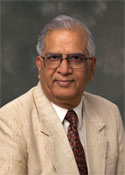February 23, 2010
New water spray system reduces dust in coal mines
CARBONDALE, Ill. -- In an underground coal mine, dust is the miner’s enemy.Particles too small to see work their way into the respiratory system, where they can accumulate and cause health problems such as pneumoconiosis or black lung in later years. Larger particles obscure visibility while others hang in the air and coat surfaces, presenting an explosion hazard.
A mining researcher at Southern Illinois University Carbondale, however, is leading an effort to cut down on the huge amounts of dust created by the large machines miners use to chew coal from the veins beneath the ground.
Yoginder “Paul” Chugh, professor in the Department of Mining and Mineral Resources in the College of Engineering, is perfecting a dust control system for retrofitting on continuous coal mining machines. Using water spray technology and strategic placement of the spray nozzles to create “curtains” around dust clouds, Chugh’s team is making huge improvements in dust control efforts at several mines.
The continuous mining machines traditionally have relied on spraying water to control dust, Chugh said. But his modified system adds more sprayers, using specific pressures and droplet sizes in strategic areas to knock down far more airborne dust.
At least two mines -- Viper in central Illinois and Sunrise Mining Co. near Terre Haute, Ind. -- are using the systems, while other mines are testing it. Chugh hopes to continue marketing the system as both an after market add-on to existing machines or perhaps a standard item on newly manufactured machines.
The large continuous mining machines use a rotating cutting drum studded with tooth-like bits to rip coal loose from the coal seams before scooping it into a conveyer system. The cutting process and the falling, tumbling coal create continuous clouds of dust that obscure the machine operator’s sight and cause health and safety risks.
Traditional machines use water spray to try to control this problem. But the systems don’t work well enough, Chugh said.
“When we cut the coal it generates a lot of dust. Some of it stays right in front of the machine at the face, some of it rolls back at roof level and just keeps going back,” he said. “We have added more lines of dust control defense and are seeing up to 50 percent reduction in the dust problem.”
Wetting the dust makes it heavier and takes it out of the air. This happens at a very small scale, with tiny droplets of water colliding with tiny dust particles. Often, however, the dust and water fail to come into contact, or the water fails to adhere to the dust particle.
Chugh’s system improves on this concept by not only wetting the dust but also using the spray to create a sort of water curtain that seals the dust at the face of the machine, away from the operator. The spray also pushes the fine dust near the roof back into the water spray area, increasing its “residence time” in that area and thereby giving it a better chance to contact water and drop out of the air.
The system uses this hydraulic spray seal technology to form a curtain from the roof of the mine down, greatly reducing the dust rollback problem. The curtain’s design forms a kind of “window” for the machine operator to clearly see the cutting drum’s work, while additional nozzles around the center of the cutting drum and coal pan at the front of the machine wet the coal further before it enters the conveyer system, cutting down further on dust.
“If you are the operator of the machine, such as a longwall shearer, the system can also create a curtain in front of you so that you get the fresh air and the dust stays away,” he said. “That’s the basic concept we’re using all around.”
The system uses off-the-shelf spray technology in new and specific ways to greatly improve the mining environment. Water pressure, droplet size and positioning are key to its success.
“We are basically using a little common sense and science to do what should have been done a long time ago,” Chugh said. “There is a lot of science and engineering we had to do to make this work.”
Chugh is working with SIUC’s Technology Transfer Program to license and market the new technology. Since 2001, SIUC's technology transfer program has processed more than 140 invention disclosures, filed 89 patents, and licensed 45 inventions. In addition, SIUC inventions have helped establish six start-up companies.
Chugh’s team includes SIUC researchers Harrold Gurley and John Pulliam, both of them former miners who have helped develop the system by testing it underground. The team is continuing tests on the dust control system as well as another new system aimed at scrubbing the air inside mines following powdered limestone application (rock dusting operation), which operators use to suppress explosion potentials.
“Our team is one of the leaders in mine dust control in the nation,” said Chugh, whose research is supported by the Illinois Clean Coal Institute of the Illinois Department of Commerce and Economic Opportunity, and regional mining companies. “We are helping miners mine more coal with less health and safety hazards.”

